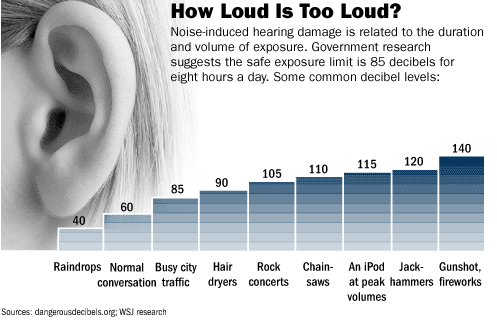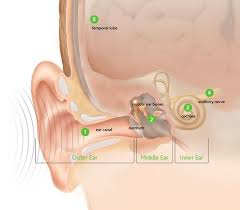Hearing Loss
Hearing loss occurs when your ability to hear is reduced, making it more difficult for you to hear speech and other sounds. It can affect anyone at any age and it often comes on gradually with age. About 10% of the world population and over 30 million Americans have some degree of hearing loss, and the causes for it vary from person to person.
As hearing loss often worsens gradually over time, many people simply aren’t aware of the problem. Unfortunately, untreated hearing loss is associated with lower quality of life, depression, social isolation, unemployment and lower earnings at work, higher medical bills for other health issues, high blood pressure and a higher risk of dangerous trips and falls.

Americans experience hearing loss

Of people do nothing about it

The average delay between the onset of hearing loss and seeking a professional diagnosis

People are effected by hearing loss in the US that can cause Tinnitus or “ringing in the ear”
Hearing loss doesn’t discriminate
It affects people of all ages and walks of life. But the incidence of hearing loss does increase significantly with age:
1/3 of people over age 65 have hearing problems
50% of those over age 75 have moderate to severe hearing loss
 How Hearing Works
How Hearing Works
Hearing is a very intricate and complex process and it’s helpful to have a basic understanding of how the auditory system works.
- Sounds enter the ear canal and travel to the eardrum.
- These sound waves cause the eardrum to vibrate, sending the bones in the middle ear into motion.
- Tiny hair cells inside the inner ear (cochlea) convert this motion into electric impulses/signals. The ear has over 25,000 tiny hair cells to help you hear the varying degrees of sound.
- These impulses/signals go up the hearing (auditory) nerve to the brain.
- The brain interprets the impulses/signals as sound and gives meaning to the information.
If any part of the outer, middle or inner ear isn’t working properly, your hearing may be affected. To gain a better understanding of hearing loss, read about the various types and degrees of hearing loss below.
Types & Degrees of Hearing Loss
Depending on which part of the ear is damaged, there are four types of hearing loss.

1. Sensorineural Hearing Loss
Sensorineural hearing loss typically occurs as you get older, but some people are born with this type of loss. Most people say they are able to hear, but don’t always understand what people are saying. It’s often confused with nerve deafness when it’s really due to problems with the inner ear.

2. Conductive Hearing Loss
When hearing loss is due to problems with the outer ear or middle ear it is called conductive hearing loss. A conductive loss is caused by something that stops sounds from getting through the external or middle ear.

3. Mixed Hearing Loss
Mixed hearing loss is a combination of conductive and sensorineural hearing loss and means that there may be damage in both the outer or middle ear and in the inner ear.

4. Single-sided Deafness
When a person has no hearing or very little hearing in only one ear and normal hearing in the other ear, it is classified as single-sided deafness.
There are Five Different Degrees of Hearing Loss

1. Mild Hearing Loss
A person with mild hearing loss is able to hear the more intense vowel sounds, but may miss some of the softer consonant sounds and need to ask people to speak up or to repeat themselves. They also may have difficulty hearing people who speak softly and the voices of young children.
2. Moderate Hearing Loss
A person with a moderate hearing loss has a difficult time hearing vowel sounds addition to missing consonant sounds. The person will often find that without hearing aids they may be able to hear, but they can’t always understand what is being said.
3. Moderately Severe Hearing Loss
For a person with moderately severe hearing, speech becomes inaudible without the use of hearing aids and even with them, speech still may still be difficult to understand.
4. Severe Hearing Loss
Without hearing aids, speech is inaudible for someone with severe hearing loss, but they are able to hear sounds like a baby crying or a dog barking.
5. Profound
For a person with profound hearing loss, speech is inaudible without hearing aids, but they can hear very loud sounds like a lawn mower or jet airplane.
Treating Hearing Loss
Step 1: Diagnosis
Before we can determine how to effectively treat any hearing problem, we begin by conducting a series of highly advanced diagnostic tests to help us pinpoint the exact type and cause of hearing loss. These include:
- Audiograms – Used to measure how well a person hears. This test is performed in a sound-proof room using an audiometer and earphones.
- Tympanometry – Assesses the status of the eardrum and middle ear.
- Otoacoustic emission testing (OAE) – Provides a measure of cochlear (inner ear) hair cell function.
- Auditory Brainstem Response or Brainstem Auditory-Evoked Response (BAER) – A useful clinical tool to help detect, localize and monitor auditory and neurotologic deficits as well as estimate hearing in difficult to test patients.
Step 2: Treatment Options
Based on the results of a series of diagnostic tests, our audiologists will evaluate a variety of options for effectively treating a patient’s particular type of hearing loss. These options include
Hearing Aids – click here for more information on types of hearing aids
Hearing Implants – A hearing implant can dramatically affect how a person with hearing loss lives their life, the way they learn and the way they engage with others. There are two kinds of hearing implants – cochlear (or inner ear) implants and implantable middle-ear devices.
- Cochlear Implant – A cochlear implant is an electronic medical device that replaces the function of the damaged inner ear.
- Unlike hearing aids, which make sounds louder, cochlear implants do the work of damaged parts of the inner ear (cochlea) to provide sound signals to the brain.
- For those with a severe to profound hearing loss in both ears, cochlear implants may be the solution. This procedure allows patients to hear actual sounds in both ears and improve their communication.
- The implants are a combination of an internal computer chip and an electrode coupled with an external speech processor and are programmed in our office by a clinical audiologist.
- Implantable Middle-Ear Devices- As an alternative to traditional hearing aids, implantable middle ear devices are an option for those with moderate to severe sensorineural (“nerve-type”) hearing loss.
- Using a processor to transmit sound that vibrates the middle ear bones directly, the implant simulates natural hearing much better than conventional hearing aids – without plugging the ear canal while also significantly reducing feedback and background noise.

Rose T.
My hearing has been deteriorating over a number of years. In the past year, I realized it was becoming progressively worse. My inability to hear well was beginning to affect both my personal and professional life. I had a hearing test and was planning to purchase traditional hearing aids. I saw an ad for the Lyric and made an appointment with Dr. Shohet. On my first visit, I walked out wearing the Lyric. I wear it 24/7 with no maintenance or batteries to replace. It is like a miracle. My hearing is so natural. I forget I am wearing the Lyric.




 How Hearing Works
How Hearing Works